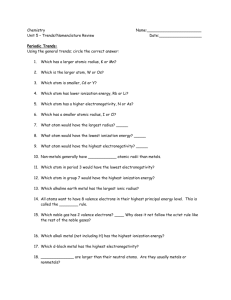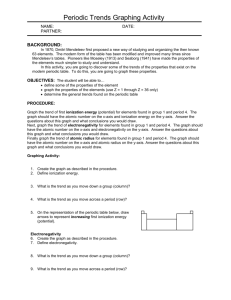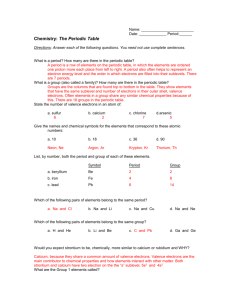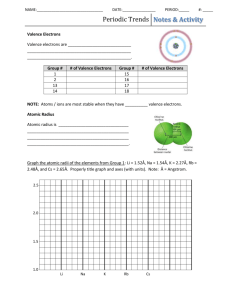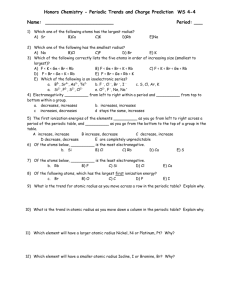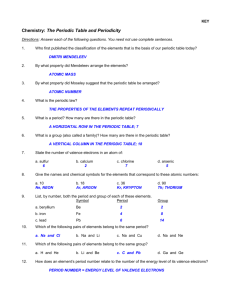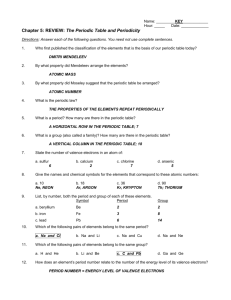Periodic Trends Practice Answer Key
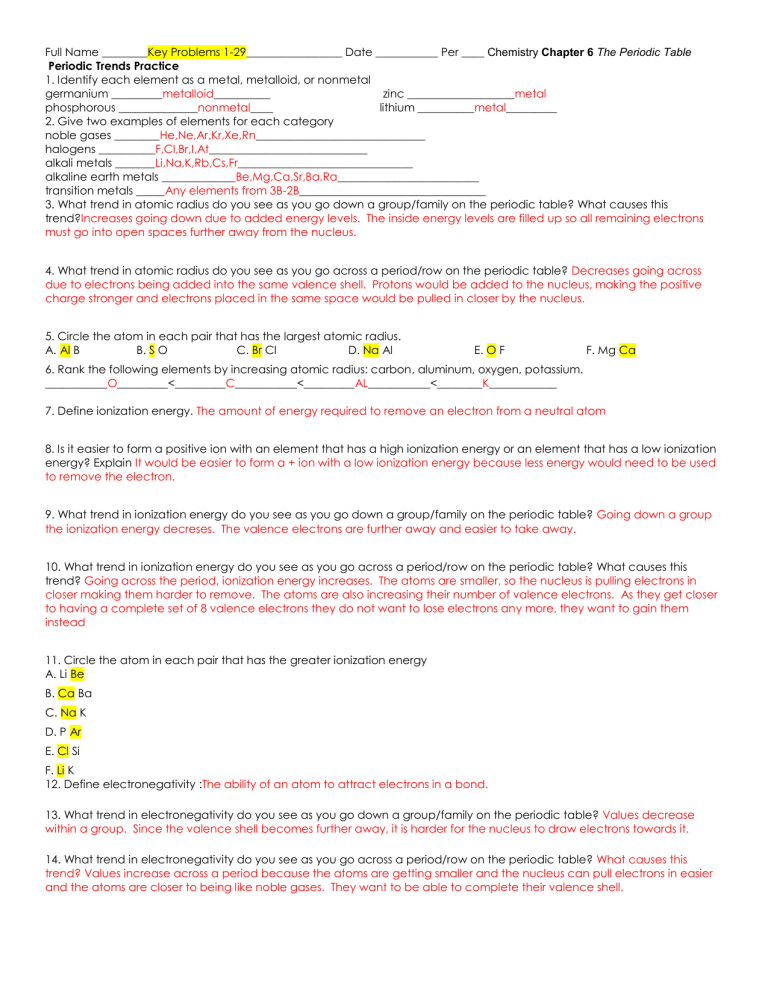
Full Name ________Key Problems 1-29_________________ Date ___________ Per ____
Chemistry Chapter 6 The Periodic Table
Periodic Trends Practice
1. Identify each element as a metal, metalloid, or nonmetal germanium _________ metalloid __________ zinc ___________________ metal phosphorous ______________ nonmetal ____ lithium __________ metal _________
2. Give two examples of elements for each category noble gases ________ He,Ne,Ar,Kr,Xe,Rn ______________________________ halogens __________ F,Cl,Br,I,At ____________________________ alkali metals _______ Li,Na,K,Rb,Cs,Fr _______________________________ alkaline earth metals _____________ Be,Mg,Ca,Sr,Ba,Ra _________________________ transition metals _____ Any elements from 3B-2B _________________________________
3. What trend in atomic radius do you see as you go down a group/family on the periodic table? What causes this trend?
Increases going down due to added energy levels. The inside energy levels are filled up so all remaining electrons must go into open spaces further away from the nucleus.
4. What trend in atomic radius do you see as you go across a period/row on the periodic table? Decreases going across due to electrons being added into the same valence shell. Protons would be added to the nucleus, making the positive charge stronger and electrons placed in the same space would be pulled in closer by the nucleus.
5. Circle the atom in each pair that has the largest atomic radius.
A. Al B B. S O C. Br Cl D. Na Al E. O F F. Mg Ca
6. Rank the following elements by increasing atomic radius: carbon, aluminum, oxygen, potassium.
___________ O _________<_________ C ___________<_________ AL ___________<________ K ____________
7. Define ionization energy. The amount of energy required to remove an electron from a neutral atom
8. Is it easier to form a positive ion with an element that has a high ionization energy or an element that has a low ionization energy? Explain It would be easier to form a + ion with a low ionization energy because less energy would need to be used to remove the electron.
9. What trend in ionization energy do you see as you go down a group/family on the periodic table?
Going down a group the ionization energy decreses. The valence electrons are further away and easier to take away.
10. What trend in ionization energy do you see as you go across a period/row on the periodic table? What causes this trend? Going across the period, ionization energy increases. The atoms are smaller, so the nucleus is pulling electrons in closer making them harder to remove. The atoms are also increasing their number of valence electrons. As they get closer to having a complete set of 8 valence electrons they do not want to lose electrons any more, they want to gain them instead
11. Circle the atom in each pair that has the greater ionization energy
A. Li Be
B. Ca Ba
C. Na K
D. P Ar
E. Cl Si
F. Li K
12. Define electronegativity : The ability of an atom to attract electrons in a bond.
13. What trend in electronegativity do you see as you go down a group/family on the periodic table? Values decrease within a group. Since the valence shell becomes further away, it is harder for the nucleus to draw electrons towards it.
14. What trend in electronegativity do you see as you go across a period/row on the periodic table? What causes this trend? Values increase across a period because the atoms are getting smaller and the nucleus can pull electrons in easier and the atoms are closer to being like noble gases. They want to be able to complete their valence shell.
15. Circle the atom in each pair that has the greater electronegativity
A. Ca Ga
B. Br As
C. Li O
D. Ba Sr
E. Cl S
F. O S
16. Rank the following elements by increasing electronegativity: sulfur, oxygen, neon, aluminum Ne,Al,S,O
17. Arrange the following atoms in order of decreasing atomic radius. Na Al P Cl Mg Cl,P,Al,Mg,Na
_________ Cl ___________<__________ P __________<_________ Al ___________<_________ Mg __________<_________ Na _
18. Which is the largest atom in Group 4A? _____________ 114 or Pb based on symbols ____________
19. Which is the smallest atom in Group 7A? _____________ F ____________
20. Which is the smallest atom in period 5? ________________ Xe _________
21. For each of the following pairs, which of the two species is larger?
A. N3- or F-___________ N-3 ______________
B. Mg2+ or Ca2+________ Ca+2 _________________
C. Fe2+ or Fe3+___________ Fe+3 ______________
22. For each of the following pairs, which of the two species is smaller?
A. K+ or Li+_______________ Li+1 __________
B. Au+ or Au3+____________Au +3 _____________
C. P3- or N3-______________ N-3 ___________
23. Order the following groups from largest to smallest radii.
A. C, Al, F, Si______ Al,Si,C,F ___________________
B. Na, Mg, Ar, P____ Na,Mg,P,Ar _____________________
C. I-, Ba2+, Cs+, Xe_______ I,Xe,Cs,Ba __________________
D. Ar, Cl-, K+, S2-___________ S,Cl,Ar,K ______________
24. The elements characterized as nonmetals are located in the periodic table at the
(A) far left; (B) bottom; (C) center; (D) top right
25. Which is the atomic number of an alkali metal?
(A) 10; (B) 11; (C) 12; (D) 13.
26. Which element is a halogen?
(A) iron; (B) nitrogen; (C) iodine; (D) neon
27. Given the same conditions, which of the following Group 7A elements has the least tendency to gain electrons?
(A) fluorine; (B) iodine; (C) bromine; (D) chlorine.
28. The alkaline earth element having the largest atomic radius is found in Period
(A) 1; (B) 2; (C) 6; (D) 7.
29. Which of the following atoms will lose an electron most readily?
(A) potassium; (B) calcium; (C) rubidium; (D) strontium
30. Which element in Group 16 (6A) has the greatest tendency to gain electrons?
(A) Te; (B) Se; (C) S; (D) O.
31. The elements known as the alkali metals are found in Group
(A) 1 (1A); (B) 2 (2A); (C) 13 (3A); (D) 17 (7A).
32. The element in Period 3 that has the highest ionization energy is
(A) an inert gas; (B) a halogen; (C) an alkali metal; (D) an alkaline earth metal
33. Which element in Period 3 has both metallic and nonmetallic properties?
(A) Na; (B) Mg; (C) Si; (D) Ar.
34. Which ion would have the smallest radius?
(A) Ba2+ ; (B) Ca2+ ; (C) Mg2+ ; (D) Sr2+
35. The most active metals are in Group
(A) 1 (IA); (B) 15 (VA); (C) 13 (IIIA); (D) 17 (VIIA).
36. Which is an example of a metalloid?
(A) sodium; (B) strontium; (C) silicon; (D) sulfur.
37. Which Period contains four elements which are gases at STP?
(A) 1; (B) 2; (C) 3; D) 4.
38. An atom in the ground state with eight valence electrons would most likely be
(A) an active metal; (B) an inactive metal; (C) a noble gas; (D) a halogen.
39. The atomic number of a metalloid in Period 4 is
(A) 19; (B) 26; (C) 33; (D) 36.
40. Which element is a liquid at STP?
(A) K; (B) I; (C) Ag; (D) Hg.
41. All elements whose atoms in the ground state have a total of 7 electrons in their outermost energy level
(A) noble gases; (B) metalloids; (C) halogens; (D) alkaline earth metals.
42. Which of the following elements has the highest electronegativity?
(A) phosphorous; (B) sulfur; (C) oxygen; (D) sodium.
43. Which element has the highest ionization energy?
(A) barium; (B) magnesium; (C) calcium; (D) strontium.
44. Which is an alkaline earth metal?
(A) Na; (B) Ca; (C) Ga; (D) Ta.
45. As one proceeds from left to right across a given period on the Periodic Table the electronegativities of the elements generally
(A) decrease; (B) increase; (C) remain the same.
46. As one proceeds from flourine to astatine in Group VIIA the electronegativity
(A) decreases and the atomic radius increases;
(B) decreases and the atomic radius decreases;
(C) increases and the atomic radius decreases;
(D) increases and the atomic radius increases


